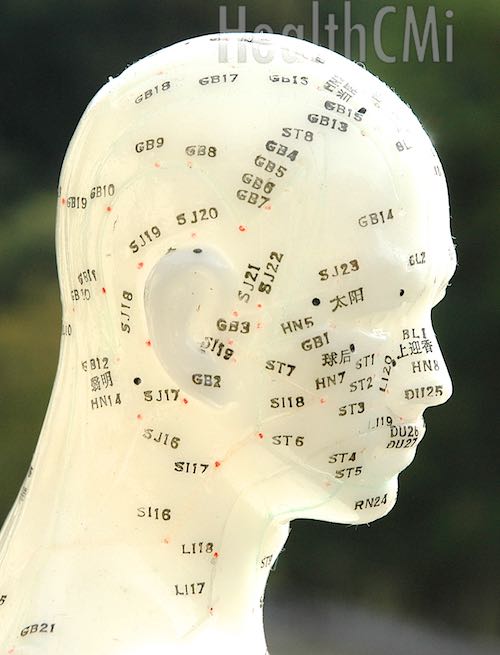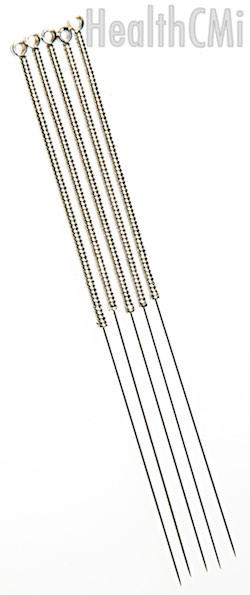Acupuncture benefits Alzheimer’s disease patients. Clinical research published in the Journal of Acupuncture and Tuina Science finds acupuncture plus moxibustion effective in improving cognitive function and improving the general quality of life for Alzheimer’s disease patients. The research, supported by the Shanghai University of Traditional Chinese Medicine, measured an 83.3% total effective rate of acupuncture combined with moxibustion. 
The acupuncture points used were GV20 (Baihui) and Sishencong (Ex-Hn-1). Filiform acupuncture needles (0.30 mm x 40-50 mm) were inserted at a 30 degree angle to the area just below the galea aponeurotica. Twirling method was applied without lifting and thrusting at a rate of 200 times per minute for 2-3 minutes followed by a needle retention time of 5 minutes prior to repeating the process. Engagement by family members involved instruction to verbally communicate and help the patient move their limbs during the needling regime.
Moxibustion was applied on top of an herbal cake comprised Fu Zi (Radix Aconiti Laterails Preparata), Ma Huang (Fructus Aristolochiae), Rou Gui (Cortex Cinnamoni), Gan Jiang (Rhizma Zingiberis), and other related herbs. The cakes were placed at GV14 (Dazhui) and BL23 (Shenshu). Moxa cones were placed on top of the cakes. The acupuncture and moxibustion treatments were applied once per day for 10 days. A three day rest period followed the treatment and this process was repeated two more times prior to clinical evaluations. The researchers concluded that acupuncture and moxibustion are “safe and effective” and are “beneficial to the general improvement of the quality of life of AD (Alzheimer’s disease) patients….”
These findings involving human clinical trials are confirmed by electron microscopy laboratory research demonstrating that acupuncture protects the brain cells of Alzheimer’s disease patients. Published in Neural Regeneration Research, investigators identified major brain structures that are preserved by using electroacupuncture and moxibustion. The research team documented a powerful neuroprotective effect induced by electroacupuncture including specific beneficial changes in brain chemistry.
Acupuncture was applied to acupuncture points GV20 (Baihui) and BL23 (Shenshu) on laboratory rats with induced Alzheimer’s disease pathology. The brains were examined with electron microscopy which revealed that rats treated with electroacupuncture preserves the hippocampus structure of the brain. The researchers discovered that “neuronal cell injury was markedly reduced” as a result of acupuncture. On the other hand, the control group that received no acupuncture or moxibustion showed enormous damage to the hippocampus.
Additional benefits were discovered. Transmission electron microscope findings revealed that electroacupuncture and moxibustion successfully downregulated axin protein expression and upregulated β-catenin protein expression. This was true for all three treatment groups: electroacupuncture only, moxibustion only and a third electroacupuncture combined with moxibustion group.
The research team reports, “The present study demonstrates that electroacupuncture pretreatment has a neuroprotective function in the hippocampus, suggesting that this technique could be used to protect learning and memory functions, and prevent senile dementia.” They added that in the hippocampus “neuronal cell injury was markedly reduced in all three pretreatment groups; organelles were visible in the cytoplasm, and chromatin appeared normal.” The researchers add that optimal results identified in the study were achieved by combining electroacupuncture with moxibustion. The investigators concluded, “The combination of moxibustion and electroacupuncture obtained a better neuroprotective effect than either technique alone….”
Electroacupuncture and moxibustion regulate axin and β-catenin in the brain. The proteins interact with each other and are part of Wnt signaling pathways, a group of signal transduction pathways composed of proteins that signal from outside a cell to its interior. The researchers note, “We therefore propose that the mechanisms of action underlying the potential benefits of acupuncture and moxibustion in the prevention and treatment of Alzheimer’s disease involve the regulation of Wnt signaling via alterations in axin and β-catenin expression.”
MRI imaging confirms that acupuncture benefits brain activity in Alzheimer’s disease patients. Researchers investigated the effects of two acupuncture points on the brains of human Alzheimer disease patients using fMRI imaging with a SIEMENS verio 3-Tesla scanner. They found that acupuncture “can enhance the hippocampal connectivity in AD (Alzheimer’s disease) patients.” The MRI scans demonstrate that acupuncture “increased connectivity” in the hippocampus in patients with AD. Alzheimer’s disease damages the hippocampus resulting in memory loss, cognitive dysfunction, dementia and disorientation.
The controlled clinical investigation of human subjects measured multiple regions of disrupted connectivity in AD patients. After acupuncture, MRI imaging revealed that AD patients had significant improvements in connectivity for both frontal and lateral temporal regions of the hippocampus. The researchers note, “Due to the cognitive impairment associated with AD, acupuncture on specific acupoints can modulate the cerebral blood flow and strengthen the hippocampal connectivity in AD patients.”
The fMRI imaging measured the effects of acupuncture points LV3 (Taichong) and LI4 (Hegu) on the brain. The researchers added that acupuncture has long-lasting and beneficial effects on the human brain. They note, “Our study provides new evidence that acupuncture has a striking, sustained effect on AD patients.”
Related research reveals that acupuncture prevents brain cell loss in memory related areas of the brain and improves cognition. The laboratory findings show that acupuncture prevents neuron loss in the hippocampus. Using a water maze test, mice who received acupuncture showed significantly less cognitive deficits. The combination of improved maze test results combined with greater preservation of brain neurons prompted the researchers to suggest that acupuncture may help human subjects suffering from cognitive disorders. The researchers note, “These results suggest that reducing neuron loss in the hippocampus by acupuncture is a potential therapeutic approach for the treatment of Alzheimer's disease and cognitive impairment diseases.”

Another investigation concludes “that EA (electroacupuncture) may be a promising treatment for AD (Alzheimer’s disease)” and “may improve cognitive function.” Brain changes in Alzheimer’s disease patients involve excess “deposition of amyloid plaques, neurofibrillary tangles, and selective neuronal loss in the frontal and temporal cortices, as well as in the hippocampus of the brain.” The research team demonstrated that electroacupuncture induces brain cell repair in the affected regions and can prevent the excess buildup of plaques.
Electroacupuncture reduces brain plaque proliferation associated with Alzheimer’s disease and associated dementia. The researchers identified the actions by which electroacupuncture exerts this therapeutic effect. Electroacupuncture decreases the formation of Aβ-42 deposits. These plaque deposits lead to neuron loss, memory impairment and dementia. Aβ1-42 deposits are cytotoxic and are a biomarker of Alzheimer’s disease. The researchers discovered that electroacupuncture “was a feasible and effective way for lowering Aβ1-42 deposits….” This is important because Aβ antagonists help to restore memory lost due to Aβ deposits in the brain. 
Neurogenesis, the creation of neurons, is the process by which neurons are generated from neural stem cells and progenitor cells. Alzheimer’s disease is characterized by a significant reduction in brain neurogenesis, especially in the hippocampus. The researchers discovered that repeated electroacupuncture treatments significantly increases neurogenesis in the hippocampus and cortex.
Brain-derived neurotrophic factor (BDNF) assists in the growth and differentiation of new neurons and synapses. It is active in the hippocampus, cortex and other areas of the brain. BDNF is important in the retention of long-term memories and neurogenesis. AD patient’s have decreased levels of BDNF in the brain, especially in the hippocampus. The researchers conclude, “Our results showed that EA (electroacupuncture) treatment significantly increased the expression of BDNF in both the hippocampus and cortex; this suggests that the increase in BDNF may be involved in the therapeutic effect of EA for AD.” The researchers added, “Our result might suggest that electroacupuncture could induce the protective effect for the central nervous system of aging and Alzheimer’s disease.”
The researchers made additional observations, “In the present study, we observed that EA stimulation significantly improved the neurological behavior performance of AD mice, and reduced the deposition of Aβ in the hippocampus and cortex. At the same time, a noticeable increase in neurogenesis and BDNF expression in the hippocampus and cortex was also detected. Thus, our preliminary presumption was that EA stimulation improved neurobehavioral performance through promoting neurogenesis and BDNF expression in the brain.” They added, “In summary, the present study demonstrated that EA stimulation in Baihui (GV 20) acupoint ameliorated learning and memory deficits and reduced Aβ42 deposit in APP/PS1 mice. We propose that the underlying mechanism of EA may be related to the promotion of neurogenesis and the up-regulation of BDNF expression in the hippocampus and cortex.”
In the study, the researchers applied dense-sparse wave electroacupuncture to acupuncture point GV20 (Baihui) at 1 mA at 2-15 Hz for 4 weeks. Treatment was applied over a period of 20 days at 30 minutes per day, 5 days per week. The point selection and stimulation methods were based on prior experiments demonstrating that GV20 “protects the brain from ischemic injury.”
Given the body of new research on the effects of acupuncture on patient’s with Alzheimer’s disease, it is reasonable to promote it as a means to prevent neurodegenerative related dysfunction. There are several barriers to care. Medicare does not cover payment for acupuncture treatments despite the need for elderly patients to receive treatment for AD. Access to acupuncture is limited due to the small amount of licensed acupuncturists in the USA and abroad. Access is also limited due to the lack of integration of acupuncture into many hospitals and biomedical clinics. Finally, there is no standard recommended protocol for MDs to refer Alzheimer’s disease patients to licensed acupuncturists.
The goal of the medical system is to provide quality and appropriate healthcare that is supported by science. Modern investigations point to the efficacy of acupuncture for the treatment of Alzheimer’s disease. The connection is clear. Increasing acupuncture availability for Alzheimer’s disease patients will improve patient outcomes.
References:
Cui, Li. "Clinical observation of acupuncture-moxibustion for Alzheimer’s disease." Journal of Acupuncture and Tuina Science 12, no. 6 (2014): 354-357.
Wei QX, Zhang XM, Yan XY, Yan YJ, Chen SL. Clinical observation of Butylphthalide plus acupuncture- moxibustion for Alzheimer’s disease. Xiandai Zhongxiyi Jiehe Zazhi, 2011, 20(3): 291-292.
Cheng HY, Yu JC, Peng YM, Chen FY, fang TG, Han JX. Progress in clinical and experimental researches of Alzheimer’s disease treated by acupuncture. Liaoning Zhongyi Zazhi, 2008, 35(4): 630-633.
Zhou, H., G. Sun, L. Kong, Y. Du, F. Shen, S. Wang, B. Chen, and X. Zeng. "Acupuncture and moxibustion reduces neuronal edema in Alzheimer's disease rats." Neural Regeneration Research 9, no. 9 (2014): 968.
Burchett SA (2000) Regulators of G Protein Signaling. J Neurochem 75:1335-1351.
Luo L, Sun GJ, Du YJ (2013) Effects of acupuncture and moxibustion on energy metabolism-related protein of hippocampai neuron mitochondria in Alzheimer’s disease rats. Zhongguo Zhenjiu 33:913-918.
Cui L, Sun G, Zhou H, Du Y (2009) Influence of pre-stimulation with acupuncture and moxibustion on learning and memory ability and the activity of SOD, NOS in hippocampal area of Alzheimer disease model rats. Hubei Zhongyi Xueyuan Xuebao 3:6-8.
Wang, Zhiqun, Peipeng Liang, Zhilian Zhao, Ying Han, Haiqing Song, Jianyang Xu, Jie Lu, and Kuncheng Li. "Acupuncture Modulates Resting State Hippocampal Functional Connectivity in Alzheimer Disease." PloS one 9, no. 3 (2014): e91160.
Li, Xuying, Fan Guo, Qiaomei Zhang, Tingting Huo, Lixin Liu, Haidong Wei, Lize Xiong, and Qiang Wang. "Electroacupuncture decreases cognitive impairment and promotes neurogenesis in the APP/PS1 transgenic mice." BMC complementary and alternative medicine 14, no. 1 (2014): 37.


